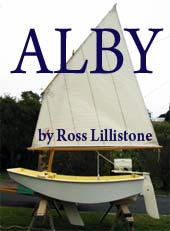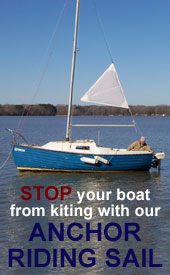
 Custom Search
|
| sails |
| plans |
| epoxy |
| rope/line |
| hardware |
| canoe/kayak |
| sailmaking |
| materials |
| models |
| media |
| tools |
| gear |
| join |
| home |
| indexes |
| classifieds |
| calendar |
| archives |
| about |
| links |
| Join Duckworks Get free newsletter CLICK HERE |
|
|
| Family Skiff |
by Tim & Susan O'Guin - Hickory Withe, Tennessee - USA |
| Here's a few pics of the Michalak Family Skiff I built, with help and supplies from Duckworks, on its maiden voyage. There's been years of delays but I'm finally learning to sail in my own homebuilt boat! The trip to nearby Pickwick Lake on the Tennessee River was overall great fun, even though a few glitches were experienced launching and loading on the home customized trailer. The river was high and full of storm debris but still beautiful! My only previous sailing experience was 40 plus years ago in a small foam and resin boat won by a friend in a Kool cigarette contest. He, having no desire to use it, left it at the small lake my brother resided on at the time and I quickly put it into use. Soon I was sailing three minutes downwind and learning to slowly tack my way back zigzagging 15 minutes or so, into the wind across the tiny lake! The boat was destroyed in a storm (left out in the weather on the bank), but I never forgot the fun, even that little bit of sailing had been! Well, this more recent experience, now in my own wooden boat was even better!
My granddaughter pointed out that all heads turned to look at our boat and I was getting awfully prideful until while launching we hung the leeboard on the trailers guide post and promptly had a minor disaster in the making! Breaking off the guide post and damaging the rear custom bunk, I finally got the boat in the water. Swallowing my pride and bravely pushing on with a smile, I refused to let this interfere with the maiden voyage of the skiff named after my mother, Ruth J Rudder! Just as she had enjoyed watching sailboats for hours we soon enjoyed actually sailing for a few hours! The winds were light most of the time but picked up just enough to let us get a taste of the fun we anticipate often in future planned trips. The boat seemed to handle well, even in my inexperienced hands. She bobbed over the wakes of massive cabin cruisers, barges and speeding powerboats that blasted by at 60 mph! We sailed a few miles up the lake past some rock cliffs festooned with blooming wildflowers and rhododendrons hanging from their craggy faces where one would least expect such displays! When we reluctantly returned to the ramp we encountered more difficulty loading, forcing me to wade in to my knees to wrangle the skiff on to its bunks! A happy but tired crew pulled up the ramp where we began to tie her down and stow our gear for the trip home. There a fisherman preparing his 200 plus horsepower state of the industry bass boat for the road came over and asked about our little wooden boat! We talked for several minutes and he praised our little boat with obvious admiration for its simple beauty and its classic wooden hull! Lessons learned, some repairs and modifications to do and we will be back sailing again, in the good skiff Ruth J Rudder! Chuck Leinweber asked me to comment a bit on the build process to satisfy any desire for such information. I could write a book on that, since it actually took me years to plan and build and colored my life brighter at a time that was difficult, personally for me! But as he asked for only a paragraph or two, I will try and keep it short and simple! I earnestly began to explore boat building, boat magazines and etc. about 10, or so, years ago. After much study, soul searching and considerations about my financial realities as well as my lack of sailing experience, I finally (after several years) decided to build a Jim Michalak design. After even more consideration (about another year) I purchased plans for the "Piccup Pram" and the new (at the time) design "The Family Skiff" through Duckworks. Eventually, I settled on the Family Skiff design because of its fairly large cockpit (7 feet long) and the large flotation/storage boxes that made me more comfortable about both safety and function! Also, it pleased my eyes more with its "salty" look! I worried with angst about what plywood to use for a while; whether to go cheap and simple, or to use quality marine1080 BS plywood. I finally made the decision and ordered Meranti 1080 BS from Boat Builders Central. There was no source for that locally in landlocked West Tennessee! Excellent service, great quality, good looks and quick delivery - I made that the right decision! I then placed the first of several orders from Duckworks Boat Builders Supply for their marine epoxy kit , excellent sail and much, much more, and as I have come to expect from them, also most excellent service! I laid out the panels and promptly zigged when I should have zagged and curved a batten wrong, drawing and then cutting a couple lines incorrectly! That later caused a larger gap between the side and bilge panels than there should be, but I carried on and just used two extra layers of fiberglass tape in those places to make up for any structural weakness that may have resulted from that error! I also had acquired donations and discounted mahogany, white oak, teak and other hardwoods from friends and associates locally, that I used in creating the wales, motorboard, mast partners and etc. Due to many factors, including reduced stamina for hard work, I worked a few hours per weekend in the spring and fall seasons only, when the weather was kindly! I would roll out the skiff on a homemade boat carriage from my garage and work in my driveway, then push it back inside when that session was complete. I finally completed the project two years after beginning the build! I was so excited and could hardly contain myself about the prospect of getting it on the water before winter (this was near the end of last September)!!! I checked with the State of Tennessee about registration for the boat and for a variety of unexplained reasons it took 7 months for the state to finally send out a Game and Fish Officer to apply the Bin numbers (boat identification numbers) that would allow me to pay taxes and register the boat! The rest is now documented on Duckworks Magazine pages and again, my thanks to the Leinwebers, for their inspiration and service to me and to all of the other boat builders and would be boat builders everywhere! |
|



